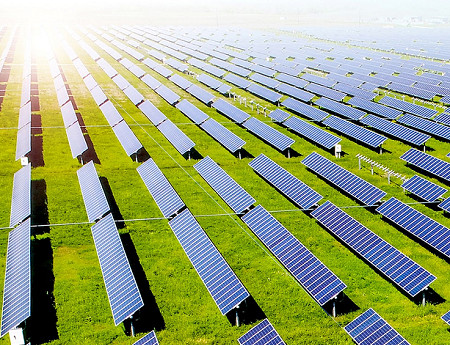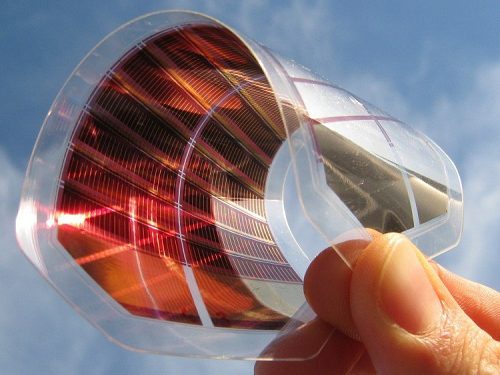
Photovoltaic cells installed in solar panels are devices that transfer the energy of the visible light into electrical energy. We asked Prof. Jakub Rysz, Director of the Jagiellonian University Marian Smoluchowski Institute of Physics, to tell us about how they work and what are the latest developments in this branch of technology.
Solar cells make use of the photovoltaic effect, a phenomenon first observed in 1839 by Alexandre-Edmond Becquerel, the father of Henri Becquerel, famously known for his work on radioactivity. Becquerel’s experiment involved placing two platinum plaques covered with silver chloride and silver bromide in an alkaline solution and exposing them to sunlight, causing potential difference between the electrodes. The next important step in the development of solar cells involved observing the photovoltaic effect in layers of selenium over gold. In the late 19th century, devices comparable to what we now call photovoltaic cells that were based on this discovery were installed in the United States. The most ubiquitous semiconductor solar cells in the world today was first proposed by a group of scientists from BellLabs, who presented the prototypical silicon cell with a p-n junction in 1954.
 Photovoltaic cells’ principles of operation can be most easily explained using the example of p-n junction device. The semiconducting materials which make up the cell absorb photons, making electrons in the lower energy state in the valence band move to a higher energy state in the conduction band. This way, a pair of charge carriers is formed: an electron in the conduction band and a hole in the valence band. The junction has a small electrical field which causes the electron and hole pairs to come apart, and the free electrons and holes move to the p-side (holes) and the n-side (electrons). This causes a difference in potentials, which in turn forces electricity to flow within the circuit with the cells.
Photovoltaic cells’ principles of operation can be most easily explained using the example of p-n junction device. The semiconducting materials which make up the cell absorb photons, making electrons in the lower energy state in the valence band move to a higher energy state in the conduction band. This way, a pair of charge carriers is formed: an electron in the conduction band and a hole in the valence band. The junction has a small electrical field which causes the electron and hole pairs to come apart, and the free electrons and holes move to the p-side (holes) and the n-side (electrons). This causes a difference in potentials, which in turn forces electricity to flow within the circuit with the cells.
The development of electronic industry has contributed to the development of semiconducting solar cells. New materials and new technologies now allow us to design devices that are very effective in transferring the energy of the visible light into electrical energy, and efficiency is the basic parameter to measure that effectiveness. Each year, the US-based National Renewable Energy Laboratory publishes a chart depicting the efficiency of the best devices available, which has now reached the level of almost 50%. Unfortunately, attaining such high a level of efficiency is very expensive, so this kind of equipment is used mostly in the space industry, but the advances made in the sector of semiconducting photovoltaic cells have caused a significant reduction in prices, making less efficient home solar panels a viable and ever more popular option.
Simultaneously with the development of silicon cells, called first generation cells, researchers have sought new ways of effectively converting solar energy into power. As a result, engineers have developed devices based on thin layers of copper, indium, gallium and selenium, commonly known as CIGS. Novel methods of synthesising semiconducting organic materials allowed for designing light and flexible ‘plastic’ solar cells that can be incorporated into clothing.
Additionally, dye-sensitised solar cells (DSSCs) use dye molecules extracted from natural sources such as plants and combined with commonly used titanium oxide. Titanium oxide can be found in a variety of everyday items such as paint, cosmetics, and even food (E117). In and of itself, it is not serviceable as a semiconductor, since it can only absorb UV light, but when combined with molecules that absorb the visible light, it becomes very effective in catching electrons and transporting them to electrodes. Layers of titanium oxides are spread on transparent electrodes, and then placed in a dyeing solution. In such cases, the counter electrode in a solar cell is a transparent layer of conducting oxide covered in platinum molecules. The electrolyte in between the electrodes allows for the flow of electrons. Moreover, using two transparent electrodes enables us to create transparent solar cells that can be fitted into a window.
The last decade saw an explosion in the popularity of cells using crystals with perovskite-like structure as light absorbing materials, hence their name, perovskite solar cells (PSCs). The most common ones are lead-methyloamine trihalogens (or similar, with other elements substituting for lead). One of the greatest advantages of perovskite solar cells is their very low cost and very high efficiency, which has now risen to as much as 25%. One of the leading manufacturers of PCSs is Saule Industries, a Polish company which has recently announced that it will open a production line that will be able to make these cells through inkjet printing.
Small scale photovoltaic installations are becoming more and more common, and that causes issues with the distribution of the power that they produce. Most of the energy from those solar cells is produced while the owners of single-family homes are at work, and the demand increases in the evening. It would be optimal if solar energy could be produced on a large scale in places where it is needed the most, e.g. in offices, but the space on the roofs of such building is limited, and oftentimes reduced even further by air conditioning and ventilation shafts. Because of this, there is a growing trend of installing solar cells on the exterior walls of buildings without compromising their aesthetic value. Building-Integrated Photovoltaics (BIPV) is increasing in popularity, with another Polish company, ML System, being one of the leaders on the European market. The diversity of technologies that can be used to make solar cells allows for a broad spectrum of production techniques that can be used as replacements for traditional building materials that would also be able to generate power.





